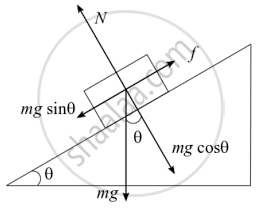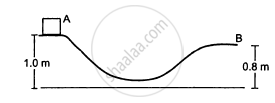Advertisements
Advertisements
प्रश्न
A block of mass 1 kg is pushed up a surface inclined to horizontal at an angle of 30° by a force of 10 N parallel to the inclined surface (Figure). The coefficient of friction between block and the incline is 0.1. If the block is pushed up by 10 m along the incline, calulate

- work done against gravity
- work done against force of friction
- increase in potential energy
- increase in kinetic energy
- work done by applied force.
उत्तर
Consider the adjacent diagram the block is pushed up by applying a force F.

Normal reaction (N) and frictional force (f) is shown.
Given, mass = m = 1 kg, θ = 30°
F = 10 N, μ = 0.1 and s = distance moved by the block along the inclined plane = 10 m
a. Work done against gravity = Increase in PE of the block
= mg × Vertical distance travelled
= mg × s(sin θ) = (mgs) sin θ
= 1 × 10 × 10 × sin 30° = 50 j ....(∵ g ≤ 10 m/s2)
b. Work done against friction
wf = f × s = μN × s = μ mg cos θ × s
= 0.1 × 1 × 10 × cos 30° × 10
= 10 × 0.866
= 8.66 J
c. Increase in PE = mgh = mg (s sin θ)
= 1 × 10 × 10 × sin 30°
= `100 xx 1/2`
= 50 J
d. By the work-energy theorem, we know that work done by all the forces = change in KE
(W) = ΔK
ΔK = Wg + Wf + Wf
⇒ = – mgh – fs + FS
= – 50 – 8.66 + 10 × 10
= – 50 – 8.66
= 41.34 J
e. Work done by the applied force, F = FS
= (10)(10)
= 100 J
APPEARS IN
संबंधित प्रश्न
If all matters were made of electrically neutral particles such as neutrons,
(a) there would be no force of friction
(b) there would be no tension in the string
(c) it would not be possible to sit on a chair
(d) the earth could not move around the sun.
Two spherical bodies, each of mass 50 kg, are placed at a separation of 20 cm. Equal charges are placed on the bodies and it is found that the force of Coulomb repulsion equals the gravitational attraction in magnitude. Find the magnitude of the charge placed on either body.
A body builder exerts a force of 150 N against a bullworker and compresses it by 20 cm. Calculate the spring constant of the spring in the bullworker.
The work done by all the forces (external and internal) on a system equals the change in ______.
A box is pushed through 4.0 m across a floor offering 100 N resistance. How much work is done by the resisting force?
A block of mass 2 kg kept at rest on an inclined plane of inclination 37° is pulled up the plane by applying a constant force of 20 N parallel to the incline. The force acts for one second. Find the kinetic energy of the block at the instant the force ceases to act. Take g = 10 m/s2.
A block of mass 2.0 kg is pushed down an inclined plane of inclination 37° with a force of 20 N acting parallel to the incline. It is found that the block moves on the incline with an acceleration of 10 m/s2. If the block started from rest, find the work done (a) by the applied force in the first second, (b) by the weight of the block in the first second and (c) by the frictional force acting on the block in the first second. Take g = 10 m/s2.
A uniform chain of length L and mass M overhangs a horizontal table with its two third part on the table. The friction coefficient between the table and the chain is μ . Find the work done by friction during the period the chain slips off the table.
A block of mass 1 kg is placed at point A of a rough track shown in figure following. If slightly pushed towards right, it stops at point B of the track. Calculate the work done by the frictional force on the block during its transit from A to B.

A body is moving unidirectionally under the influence of a source of constant power supplying energy. Which of the diagrams shown in figure correctly shows the displacement-time curve for its motion?
